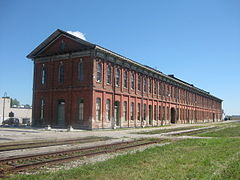Canada Southern Railway Station
| Canada Southern Railway Station | |
|---|---|
| CASO Station | |

Southwest corner of the station
|
|
| General information | |
| Type | Railway Station |
| Architectural style | Italianate |
| Address | 750 Talbot Street, St. Thomas, Ontario |
| Town or city | St. Thomas, Ontario |
| Country | Canada |
| Coordinates | 42°46′40″N 81°11′10″W / 42.7779°N 81.1861°WCoordinates: 42°46′40″N 81°11′10″W / 42.7779°N 81.1861°W |
| Construction started | 1871 |
| Completed | 1873 |
| Cost | $10,000 - 12,000 |
| Owner | North America Railway Hall of Fame |
| Technical details | |
| Floor count | 2 |
| Lifts/elevators | 1 |
| Design and construction | |
| Architect | Edgar Berryman (1839-1905) |
| Designations | Ontario Heritage Trust Plaque |
| Other information | |
| Parking | Yes, Free |
| Website | |
| The North America Railway Hall of Fame: Canada Southern Station, Inductee Page | |
The Canada Southern Railway Station is a former railway station in St. Thomas, Ontario, Canada. The station was built by the Canada Southern Railway and last had train service in 1979. It is now home to the North America Railway Hall of Fame.
Historically, the station was, at one time, one of the busiest train stations in Canada, headquarters to the Canada Southern Railway and is currently owned by, and home to the North America Railway Hall of Fame. Since the CASO Station was acquired by the North America Railway Hall of Fame in 2005, the goal is to restore the station to its "illustrious state of the 1914-1925 eras"
The Canada Southern Railway line ran from Detroit to Buffalo. It provided an efficient path for travelers who took the short route through southern Ontario. As the line grew, the town of St. Thomas, Ontario offered a $25,000 bonus to the Canada Southern Railway if they built their head offices within the borders of the town. The Canada Southern acquiesced and the CASO station was built. As a direct result, the population of St. Thomas quadrupled in the span of not much more than a decade.
Though it was one of 31 railway station built in Ontario during the 1870s, CASO was unique, in that it was designed in an Italianate style by Canadian architect Edgar Berryman (1839-1905,) and is thought to be the only station of that type in Canada. It is also the largest of them all. More common designs for major railway stations of the times included Romanesque, Beaux-Arts and Second Empire architectural styles.
The building itself is 107.9 metres (354 feet) long and 10.9 metres (36 feet) wide. The station boast two stories – both with ceilings of approximately 5.5-6.1 metres (18–20 feet) featuring 164 arched windows. Its original 400,000 white brick construction was later painted red to suit the style of the day. The original cost of the CASO station was estimated at between $10,000 - $12,000 dollars in 1873.
The Canada Southern Station did double duty. It became a busy “port of call” for numerous lines, while the second floor of the building was home to the Canadian head offices of the Canada Southern Line. Currently, much of the second floor is rented out and generates revenue to maintain the station.
...
Wikipedia
